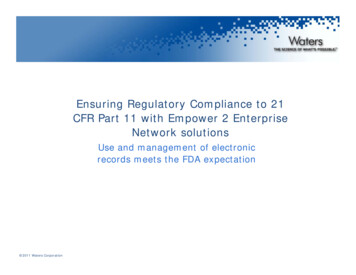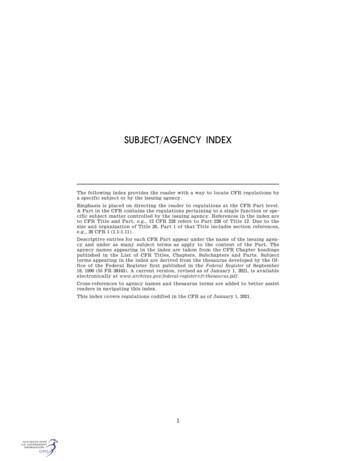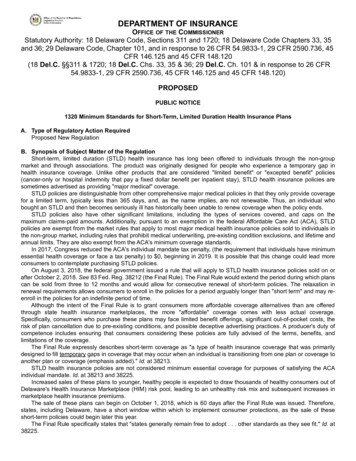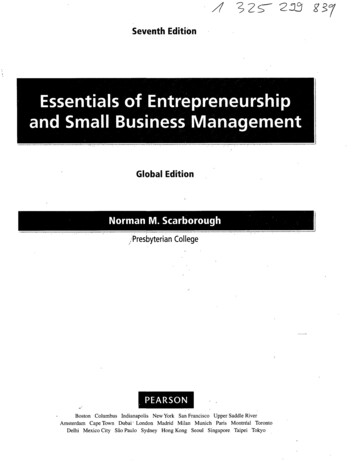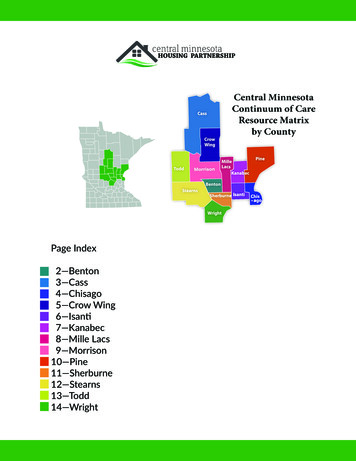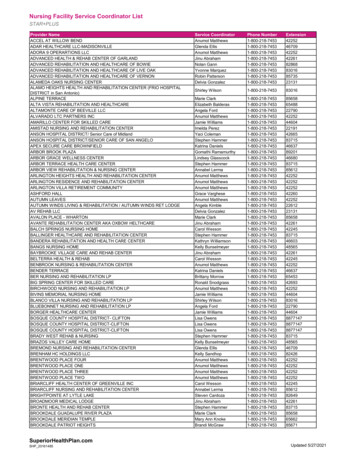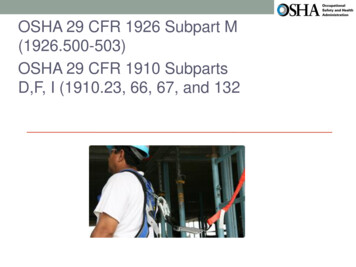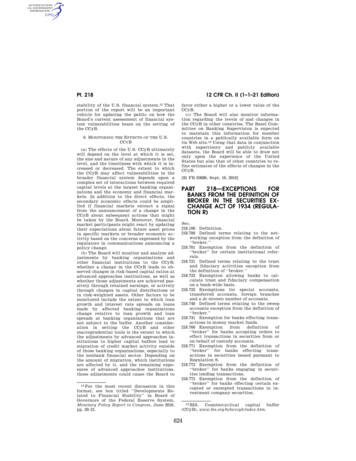
Transcription
Pt. 21812 CFR Ch. II (1–1–21 Edition)stability of the U.S. financial system.12 Thatportion of the report will be an importantvehicle for updating the public on how theBoard’s current assessment of financial system vulnerabilities bears on the setting ofthe CCyB.6. MONITORING THE EFFECTS OF THE U.S.CCYBkpayne on VMOFRWIN702 with JOB(a) The effects of the U.S. CCyB ultimatelywill depend on the level at which it is set,the size and nature of any adjustments in thelevel, and the timeliness with which it is increased or decreased. The extent to whichthe CCyB may affect vulnerabilities in thebroader financial system depends upon acomplex set of interactions between requiredcapital levels at the largest banking organizations and the economy and financial markets. In addition to the direct effects, thesecondary economic effects could be amplified if financial markets extract a signalfrom the announcement of a change in theCCyB about subsequent actions that mightbe taken by the Board. Moreover, financialmarket participants might react by updatingtheir expectations about future asset pricesin specific markets or broader economic activity based on the concerns expressed by theregulators in communications announcing apolicy change.(b) The Board will monitor and analyze adjustments by banking organizations andother financial institutions to the CCyB:whether a change in the CCyB leads to observed changes in risk-based capital ratios atadvanced approaches institutions, as well aswhether those adjustments are achieved passively through retained earnings, or activelythrough changes in capital distributions orin risk-weighted assets. Other factors to bemonitored include the extent to which loangrowth and interest rate spreads on loansmade by affected banking organizationschange relative to loan growth and loanspreads at banking organizations that arenot subject to the buffer. Another consideration in setting the CCyB and othermacroprudential tools is the extent to whichthe adjustments by advanced approaches institutions to higher capital buffers lead tomigration of credit market activity outsideof those banking organizations, especially tothe nonbank financial sector. Depending onthe amount of migration, which institutionsare affected by it, and the remaining exposures of advanced approaches institutions,those adjustments could cause the Board to12 For the most recent discussion in thisformat, see box titled ‘‘Developments Related to Financial Stability’’ in Board ofGovernors of the Federal Reserve System,Monetary Policy Report to Congress, June 2016,pp. 20–21.favor either a higher or a lower value of theCCyB.(c) The Board will also monitor information regarding the levels of and changes inthe CCyB in other countries. The Basel Committee on Banking Supervision is expectedto maintain this information for membercountries in a publically available form onits Web site.13 Using that data in conjunctionwith supervisory and publicly availabledatasets, the Board will be able to draw notonly upon the experience of the UnitedStates but also that of other countries to refine estimates of the effects of changes in theCCyB.[81 FR 63686, Sept. 16, 2016]PART218—EXCEPTIONSFORBANKS FROM THE DEFINITION OFBROKER IN THE SECURITIES EXCHANGE ACT OF 1934 (REGULATION R)Sec.218.100 Definition.218.700 Defined terms relating to the networking exception from the definition of‘‘broker.’’218.701 Exemption from the definition of‘‘broker’’ for certain institutional referrals.218.721 Defined terms relating to the trustand fiduciary activities exception fromthe definition of ‘‘broker.’’218.722 Exemption allowing banks to calculate trust and fiduciary compensationon a bank-wide basis.218.723 Exemptions for special accounts,transferred accounts, foreign branchesand a de minimis number of accounts.218.740 Defined terms relating to the sweepaccounts exception from the definition of‘‘broker.’’218.741 Exemption for banks effecting transactions in money market funds.218.760 Exemptionfromdefinitionof‘‘broker’’ for banks accepting orders toeffect transactions in securities from oron behalf of custody accounts.218.771 Exemption from the definition of‘‘broker’’ for banks effecting transactions in securities issued pursuant toRegulation S.218.772 Exemption from the definition of‘‘broker’’ for banks engaging in securities lending transactions.218.775 Exemption from the definition of‘‘broker’’ for banks effecting certain excepted or exempted transactions in investment company securities.13 BIS,Countercyclicalcapitalbuffer(CCyB), www.bis.org/bcbs/ccyb/index.htm.624VerDate Sep 11 201416:36 Aug 05, 2021Jkt 253036PO 00000Frm 00634Fmt 8010Sfmt 8010Q:\12\12V2.TXTPC31
Federal Reserve System§ 218.700218.776 Exemption from the definition of‘‘broker’’ for banks effecting certain excepted or exempted transactions in acompany’s securities for its employeebenefit plans.218.780 Exemption for banks from liabilityunder section 29 of the Securities Exchange Act of 1934.218.781 Exemption from the definition of‘‘broker’’ for banks for a limited periodof time.AUTHORITY: 15 U.S.C. 78c(a)(4)(F).SOURCE: Reg. R, 72 FR 56554, Oct. 3, 2007,unless otherwise noted.kpayne on VMOFRWIN702 with JOB§ 218.100 Definition.For purposes of this part the following definition shall apply: Actmeans the Securities Exchange Act of1934 (15 U.S.C. 78a et seq.).§ 218.700 Defined terms relating to thenetworking exception from the definition of ‘‘broker.’’When used with respect to the ThirdParty Brokerage Arrangements (‘‘Networking’’) Exception from the definition of the term ‘‘broker’’ in section3(a)(4)(B)(i) of the Act (15 U.S.C.78c(a)(4)(B)(i)) in the context of transactions with a customer, the followingterms shall have the meaning provided:(a) Contingent on whether the referralresults in a transaction means dependenton whether the referral results in apurchase or sale of a security; whetheran account is opened with a broker ordealer; whether the referral results in atransaction involving a particular typeof security; or whether it results inmultiple securities transactions; provided, however, that a referral fee maybe contingent on whether a customer:(1) Contacts or keeps an appointmentwith a broker or dealer as a result ofthe referral; or(2) Meets any objective, base-linequalification criteria established bythe bank or broker or dealer for customer referrals, including such criteriaas minimum assets, net worth, income,or marginal federal or state income taxrate, or any requirement for citizenship or residency that the broker ordealer, or the bank, may have established generally for referrals for securities brokerage accounts.(b)(1) Incentive compensation meanscompensation that is intended to encourage a bank employee to refer cus-tomers to a broker or dealer or give abank employee an interest in the success of a securities transaction at abroker or dealer. The term does not include compensation paid by a bankunder a bonus or similar plan that is:(i) Paid on a discretionary basis; and(ii) Based on multiple factors or variables and:(A) Those factors or variables includemultiple significant factors or variables that are not related to securitiestransactions at the broker or dealer;(B) A referral made by the employeeis not a factor or variable in determining the employee’s compensationunder the plan; and(C) The employee’s compensationunder the plan is not determined byreference to referrals made by anyother person.(2) Nothing in this paragraph (b)shall be construed to prevent a bankfrom compensating an officer, directoror employee under a bonus or similarplan on the basis of any measure of theoverall profitability or revenue of:(i) The bank, either on a stand-aloneor consolidated basis;(ii) Any affiliate of the bank (otherthan a broker or dealer), or any operating unit of the bank or an affiliate(other than a broker or dealer), if theaffiliate or operating unit does notover time predominately engage in thebusiness of making referrals to abroker or dealer; or(iii) A broker or dealer if:(A) Such measure of overall profitability or revenue is only one of multiple factors or variables used to determine the compensation of the officer,director or employee;(B) The factors or variables used todetermine the compensation of the officer, director or employee includemultiple significant factors or variables that are not related to the profitability or revenue of the broker ordealer;(C) A referral made by the employeeis not a factor or variable in determining the employee’s compensationunder the plan; and(D) The employee’s compensationunder the plan is not determined byreference to referrals made by anyother person.625VerDate Sep 11 201416:36 Aug 05, 2021Jkt 253036PO 00000Frm 00635Fmt 8010Sfmt 8010Q:\12\12V2.TXTPC31
kpayne on VMOFRWIN702 with JOB§ 218.70112 CFR Ch. II (1–1–21 Edition)(c) Nominal one-time cash fee of a fixeddollar amount means a cash paymentfor a referral, to a bank employee whowas personally involved in referringthe customer to the broker or dealer,in an amount that meets any of the following standards:(1) The payment does not exceed:(i) Twice the average of the minimum and maximum hourly wage established by the bank for the currentor prior year for the job family that includes the employee; or(ii) 1/1000th of the average of the minimum and maximum annual base salary established by the bank for thecurrent or prior year for the job familythat includes the employee; or(2) The payment does not exceedtwice the employee’s actual base hourly wage or 1/1000th of the employee’sactual annual base salary; or(3) The payment does not exceedtwenty-five dollars ( 25), as adjusted inaccordance with paragraph (f) of thissection.(d) Job family means a group of jobsor positions involving similar responsibilities, or requiring similar skills,education or training, that a bank, or aseparate unit, branch or department ofa bank, has established and uses in theordinary course of its business to distinguish among its employees for purposes of hiring, promotion, and compensation.(e) Referral means the action takenby one or more bank employees to direct a customer of the bank to a brokeror dealer for the purchase or sale of securities for the customer’s account.(f) Inflation adjustment—(1) In general.On April 1, 2012, and on the 1st day ofeach subsequent 5-year period, the dollar amount referred to in paragraph(c)(3) of this section shall be adjustedby:(i) Dividing the annual value of theEmployment Cost Index For Wages andSalaries, Private Industry Workers (orany successor index thereto), as published by the Bureau of Labor Statistics, for the calendar year precedingthe calendar year in which the adjustment is being made by the annualvalue of such index (or successor) forthe calendar year ending December 31,2006; and(ii) Multiplying the dollar amount bythe quotient obtained in paragraph(f)(1)(i) of this section.(2) Rounding. If the adjusted dollaramount determined under paragraph(f)(1) of this section for any period isnot a multiple of 1, the amount so determined shall be rounded to the nearest multiple of 1.§ 218.701 Exemption from the definition of ‘‘broker’’ for certain institutional referrals.(a) General. A bank that meets the requirements for the exception from thedefinition of ‘‘broker’’ under section3(a)(4)(B)(i) of the Act (15 U.S.C.78c(a)(4)(B)(i)), other than section3(a)(4)(B)(i)(VI) of the Act (15 U.S.C.78c(a)(4)(B)(i)(VI)), is exempt from theconditions of section 3(a)(4)(B)(i)(VI) ofthe Act solely to the extent that abank employee receives a referral feefor referring a high net worth customeror institutional customer to a brokeror dealer with which the bank has acontractual or other written arrangement of the type specified in section3(a)(4)(B)(i) of the Act, if:(1) Bank employee. (i) The bank employee is:(A) Not registered or approved, orotherwise required to be registered orapproved, in accordance with the qualification standards established by therules of any self-regulatory organization;(B) Predominantly engaged in banking activities other than making referrals to a broker or dealer; and(C) Not subject to statutory disqualification, as that term is defined in section 3(a)(39) of the Act (15 U.S.C.78c(a)(39)), except subparagraph (E) ofthat section; and(ii) The high net worth customer orinstitutional customer is encounteredby the bank employee in the ordinarycourse of the employee’s assigned duties for the bank.(2) Bank determinations and obligations—(i) Disclosures. The bank providesthe high net worth customer or institutional customer the information setforth in paragraph (b) of this section(A) In writing prior to or at the timeof the referral; or(B) Orally prior to or at the time ofthe referral and626VerDate Sep 11 201416:36 Aug 05, 2021Jkt 253036PO 00000Frm 00636Fmt 8010Sfmt 8010Q:\12\12V2.TXTPC31
kpayne on VMOFRWIN702 with JOBFederal Reserve System§ 218.701(1) The bank provides such information to the customer in writing within3 business days of the date on whichthe bank employee refers the customerto the broker or dealer; or(2) The written agreement betweenthe bank and the broker or dealer provides for the broker or dealer to provide such information to the customerin writing in accordance with paragraph (a)(3)(i) of this section.(ii) Customer qualification. (A) In thecase of a customer that is a not a natural person, the bank has a reasonablebasis to believe that the customer is aninstitutional customer before the referral fee is paid to the bank employee.(B) In the case of a customer that isa natural person, the bank has a reasonable basis to believe that the customer is a high net worth customerprior to or at the time of the referral.(iii) Employee qualification information. Before a referral fee is paid to abank employee under this section, thebank provides the broker or dealer thename of the employee and such otheridentifying information that may benecessary for the broker or dealer todetermine whether the bank employeeis registered or approved, or otherwiserequired to be registered or approved,in accordance with the qualificationstandards established by the rules ofany self-regulatory organization or issubject to statutory disqualification,as that term is defined in section3(a)(39) of the Act (15 U.S.C. 78c(a)(39)),except subparagraph (E) of that section.(iv) Good faith compliance and corrections. A bank that acts in good faithand that has reasonable policies andprocedures in place to comply with therequirements of this section shall notbe considered a ‘‘broker’’ under section3(a)(4) of the Act (15 U.S.C. 78c(a)(4))solely because the bank fails to complywith the provisions of this paragraph(a)(2) with respect to a particular customer if the bank:(A) Takes reasonable and promptsteps to remedy the error (such as, forexample, by promptly making the required determination or promptly providing the broker or dealer the required information); and(B) Makes reasonable efforts to reclaim the portion of the referral feepaid to the bank employee for the referral that does not, following any required remedial action, meet the requirements of this section and that exceeds the amount otherwise permittedunder section 3(a)(4)(B)(i)(VI) of theAct (15 U.S.C. 78c(a)(4)(B)(i)(VI)) and§ 218.700.(3) Provisions of written agreement. Thewritten agreement between the bankand the broker or dealer shall requirethat:(i) Broker-dealer written disclosures. If,pursuant to paragraph (a)(2)(i)(B)(2) ofthis section, the broker or dealer is toprovide the customer in writing thedisclosures set forth in paragraph (b) ofthis section, the broker or dealer provides such information to the customerin writing:(A) Prior to or at the time the customer begins the process of opening anaccount at the broker or dealer, if thecustomer does not have an accountwith the broker or dealer; or(B) Prior to the time the customerplaces an order for a securities transaction with the broker or dealer as aresult of the referral, if the customeralready has an account at the brokeror dealer.(ii) Customer and employee qualifications. Before the referral fee is paid tothe bank employee:(A) The broker or dealer determinethat the bank employee is not subjectto statutory disqualification, as thatterm is defined in section 3(a)(39) of theAct (15 U.S.C. 78c(a)(39)), except subparagraph (E) of that section; and(B) The broker or dealer has a reasonable basis to believe that the customer is a high net worth customer oran institutional customer.(iii) Suitability or sophistication determination by broker or dealer—(A) Contingent referral fees. In any case in whichpayment of the referral fee is contingent on completion of a securitiestransaction at the broker or dealer, thebroker or dealer, before such securitiestransaction is conducted, perform asuitability analysis of the securitiestransaction in accordance with therules of the broker or dealer’s applicable self-regulatory organization as ifthe broker or dealer had recommendedthe securities transaction.627VerDate Sep 11 201416:36 Aug 05, 2021Jkt 253036PO 00000Frm 00637Fmt 8010Sfmt 8010Q:\12\12V2.TXTPC31
kpayne on VMOFRWIN702 with JOB§ 218.70112 CFR Ch. II (1–1–21 Edition)(B) Non-contingent referral fees. In anycase in which payment of the referralfee is not contingent on the completionof a securities transaction at thebroker or dealer, the broker or dealer,before the referral fee is paid, either:(1) Determine that the customer:(i) Has the capability to evaluate investment risk and make independentdecisions; and(ii) Is exercising independent judgment based on the customer’s ownindependent assessment of the opportunities and risks presented by a potential investment, market factors andother investment considerations; or(2) Perform a suitability analysis ofall securities transactions requested bythe customer contemporaneously withthe referral in accordance with therules of the broker or dealer’s applicable self-regulatory organization as ifthe broker or dealer had recommendedthe securities transaction.(iv) Notice to the customer. The brokeror dealer inform the customer if thebroker or dealer determines that thecustomer or the securities transaction(s) to be conducted by the customer does not meet the applicablestandard set forth in paragraph(a)(3)(iii) of this section.(v) Notice to the bank. The broker ordealer promptly inform the bank if thebroker or dealer determines that:(A) The customer is not a high networth customer or institutional customer, as applicable; or(B) The bank employee is subject tostatutory disqualification, as thatterm is defined in section 3(a)(39) of theAct (15 U.S.C. 78c(a)(39)), except subparagraph (E) of that section.(b) Required disclosures. The disclosures provided to the high net worthcustomer or institutional customerpursuant to paragraphs (a)(2)(i) or(a)(3)(i) of this section shall clearly andconspicuously disclose:(1) The name of the broker or dealer;and(2) That the bank employee participates in an incentive compensationprogram under which the bank employee may receive a fee of more thana nominal amount for referring thecustomer to the broker or dealer andpayment of this fee may be contingenton whether the referral results in atransaction with the broker or dealer.(c) Receipt of other compensation.Nothing in this section prevents or prohibits a bank from paying or a bankemployee from receiving any type ofcompensation that would not be considered incentive compensation under§ 218.700(b)(1) or that is described in§ 218.700(b)(2).(d) Definitions. When used in this section:(1) High net worth customer—(i) General. High net worth customer means:(A) Any natural person who, eitherindividually or jointly with his or herspouse, has at least 5 million in networth excluding the primary residenceand associated liabilities of the personand, if applicable, his or her spouse;and(B) Any revocable, inter vivos or living trust the settlor of which is a natural person who, either individually orjointly with his or her spouse, meetsthe net worth standard set forth inparagraph (d)(1)(i)(A) of this section.(ii) Individual and spousal assets. Indetermining whether any person is ahigh net worth customer, there may beincluded in the assets of such person(A) Any assets held individually;(B) If the person is acting jointlywith his or her spouse, any assets ofthe person’s spouse (whether or notsuch assets are held jointly); and(C) If the person is not acting jointlywith his or her spouse, fifty percent ofany assets held jointly with such person’s spouse and any assets in whichsuch person shares with such person’sspouse a community property or similar shared ownership interest.(2) Institutional customer means anycorporation, partnership, limited liability company, trust or other nonnatural person that has, or is controlled by a non-natural person thathas, at least:(i) 10 million in investments; or(ii) 20 million in revenues; or(iii) 15 million in revenues if thebank employee refers the customer tothe broker or dealer for investmentbanking services.(3) Investment banking services includes, without limitation, acting asan underwriter in an offering for anissuer; acting as a financial adviser in628VerDate Sep 11 201416:36 Aug 05, 2021Jkt 253036PO 00000Frm 00638Fmt 8010Sfmt 8010Q:\12\12V2.TXTPC31
kpayne on VMOFRWIN702 with JOBFederal Reserve System§ 218.721a merger, acquisition, tender offer orsimilar transaction; providing venturecapital, equity lines of credit, privateinvestment-private equity transactionsor similar investments; serving asplacement agent for an issuer; and engaging in similar activities.(4) Referral fee means a fee (paid inone or more installments) for the referral of a customer to a broker or dealerthat is:(i) A predetermined dollar amount, ora dollar amount determined in accordance with a predetermined formula(such as a fixed percentage of the dollar amount of total assets placed in anaccount with the broker or dealer),that does not vary based on:(A) The revenue generated by or theprofitability of securities transactionsconducted by the customer with thebroker or dealer; or(B) The quantity, price, or identity ofsecurities transactions conducted overtime by the customer with the brokeror dealer; or(C) The number of customer referralsmade; or(ii) A dollar amount based on a fixedpercentage of the revenues received bythe broker or dealer for investmentbanking services provided to the customer.(e) Inflation adjustments—(1) In general. On April 1, 2012, and on the 1st dayof each subsequent 5-year period, eachdollar amount in paragraphs (d)(1) and(d)(2) of this section shall be adjustedby:(i) Dividing the annual value of thePersonal Consumption ExpendituresChain-Type Price Index (or any successor index thereto), as published bythe Department of Commerce, for thecalendar year preceding the calendaryear in which the adjustment is beingmade by the annual value of such index(or successor) for the calendar yearending December 31, 2006; and(ii) Multiplying the dollar amount bythe quotient obtained in paragraph(e)(1)(i) of this section.(2) Rounding. If the adjusted dollaramount determined under paragraph(e)(1) of this section for any period isnot a multiple of 100,000, the amountso determined shall be rounded to thenearest multiple of 100,000.[Reg. R, 72 FR 56554, Oct. 3, 2007, as amendedat 73 FR 20780, Apr. 17, 2008]§ 218.721 Defined terms relating to thetrust and fiduciary activities exception from the definition of ‘‘broker.’’(a) Defined terms for chiefly compensated test. For purposes of this partand section 3(a)(4)(B)(ii) of the Act (15U.S.C. 78c(a)(4)(B)(ii)), the followingterms shall have the meaning provided:(1) Chiefly compensated—account-byaccount test. Chiefly compensated shallmean the relationship-total compensationpercentage for each trust or fiduciary account of the bank is greater than 50percent.(2) The relationship-total compensationpercentage for a trust or fiduciary account shall be the mean of the yearlycompensation percentage for the accountfor the immediately preceding year andthe yearly compensation percentage forthe account for the year immediatelypreceding that year.(3) The yearly compensation percentagefor a trust or fiduciary account shall be(i) Equal to the relationship compensation attributable to the trust or fiduciary account during the year dividedby the total compensation attributableto the trust or fiduciary account duringthat year, with the quotient expressedas a percentage; and(ii) Calculated within 60 days of theend of the year.(4) Relationship compensation meansany compensation a bank receives attributable to a trust or fiduciary account that consists of:(i) An administration fee, including,without limitation, a fee paid—(A) For personal services, tax preparation, or real estate settlement services;(B) For disbursing funds from, or forrecording receipt of payments to, atrust or fiduciary account;(C) In connection with securitieslending or borrowing transactions;(D) For custody services; or(E) In connection with an investmentin shares of an investment company forpersonal service, the maintenance ofshareholder accounts or any service described in paragraph (a)(4)(iii)(C) ofthis section;629VerDate Sep 11 201416:36 Aug 05, 2021Jkt 253036PO 00000Frm 00639Fmt 8010Sfmt 8010Q:\12\12V2.TXTPC31
kpayne on VMOFRWIN702 with JOB§ 218.72212 CFR Ch. II (1–1–21 Edition)(ii) An annual fee (payable on amonthly, quarterly or other basis), including, without limitation, a fee paidfor assessing investment performanceor for reviewing compliance with applicable investment guidelines or restrictions;(iii) A fee based on a percentage ofassets under management, including,without limitation, a fee paid(A) Pursuant to a plan under§ 270.12b–1;(B) In connection with an investmentin shares of an investment company forpersonal service or the maintenance ofshareholder accounts;(C) Based on a percentage of assetsunder management for any of the following services—(1) Providing transfer agent or subtransfer agent services for beneficialowners of investment company shares;(2) Aggregating and processing purchase and redemption orders for investment company shares;(3) Providing beneficial owners withaccount statements showing their purchases, sales, and positions in the investment company;(4) Processing dividend payments forthe investment company;(5) Providing sub-accounting servicesto the investment company for sharesheld beneficially;(6) Forwarding communications fromthe investment company to the beneficial owners, including proxies, shareholder reports, dividend and tax notices, and updated prospectuses; or(7) Receiving, tabulating, and transmitting proxies executed by beneficialowners of investment company shares;(D) Based on the financial performance of the assets in an account; or(E) For the types of services described in paragraph (a)(4)(i)(C) or (D)of this section if paid based on a percentage of assets under management;(iv) A flat or capped per order processing fee, paid by or on behalf of a customer or beneficiary, that is equal tonot more than the cost incurred by thebank in connection with executing securities transactions for trust or fiduciary accounts; or(v) Any combination of such fees.(5) Trust or fiduciary account meansan account for which the bank acts ina trustee or fiduciary capacity as de-fined in section 3(a)(4)(D) of the Act (15U.S.C. 78c(a)(4)(D)).(6) Year means a calendar year, or fiscal year consistently used by the bankfor recordkeeping and reporting purposes.(b) Revenues derived from transactionsconducted under other exceptions or exemptions. For purposes of calculatingthe yearly compensation percentage for atrust or fiduciary account, a bank mayat its election exclude the compensation associated with any securitiestransaction conducted in accordancewiththeexceptionsinsection3(a)(4)(B)(i) or sections 3(a)(4)(B)(iii)–(xi) of the Act (15 U.S.C. 78c(a)(4)(B)(i)or 78c(a)(4)(B)(iii)–(xi)) and the rulesissued thereunder, including any exemption related to such exceptionsjointly adopted by the Commission andthe Board, provided that if the bankelects to exclude such compensation,the bank must exclude the compensation from both the relationship compensation (if applicable) and total compensation for the account.(c) Advertising restrictions—(1) In general. A bank complies withthe advertising restriction in section3(a)(4)(B)(ii)(II) of the Act (15 U.S.C.78c(a)(4)(B)(ii)(II)) if advertisements byor on behalf of the bank do not advertise—(i) That the bank provides securitiesbrokerage services for trust or fiduciary accounts except as part of advertising the bank’s broader trust or fiduciary services; and(ii) The securities brokerage servicesprovided by the bank to trust or fiduciary accounts more prominently thanthe other aspects of the trust or fiduciary services provided to such accounts.(2) Advertisement. For purposes of thissection, the term advertisement has thesame meaning as in § 218.760(h)(2).[Reg. R, 72 FR 56554, Oct. 3, 2007, as amendedat 73 FR 20780, Apr. 17, 2008]§ 218.722 Exemption allowing banks tocalculate trust and fiduciary compensation on a bank-wide basis.(a) General. A bank is exempt frommeeting the ‘‘chiefly compensated’’condition in section 3(a)(4)(B)(ii)(I) ofthe Act (15 U.S.C. 78c(a)(4)(B)(ii)(I)) tothe extent that it effects transactions630VerDate Sep 11 201416:36 Aug 05, 2021Jkt 253036PO 00000Frm 00640Fmt 8010Sfmt 8010Q:\12\12V2.TXTPC31
kpayne on VMOFRWIN702 with JOBFederal Reserve System§ 218.723in securities for any account in a trustee or fiduciary capacity within thescope of section 3(a)(4)(D) of the Act (15U.S.C. 78c(a)(4)(D)) if:(1) The bank meets the other conditions for the exception from the definition of the term ‘‘broker’’ under sections 3(a)(4)(B)(ii) and 3(a)(4)(C) of theAct (15 U.S.C. 78c(a)(4)(B)(ii) and 15U.S.C. 78c(a)(4)(C)), including the advertisingrestrictionsinsection3(a)(4)(B)(ii)(II) of the Act (15 U.S.C.78c(a)(4)(B
Nothing in this section prevents or pro-hibits a bank from paying or a bank employee from receiving any type of compensation that would not be con-sidered incentive compensation under §218.700(b)(1) or that is described in §218.700(b)(2). (d) Definitions. When used in this sec-tion: (1) High net worth customer—(i) Gen-eral.
